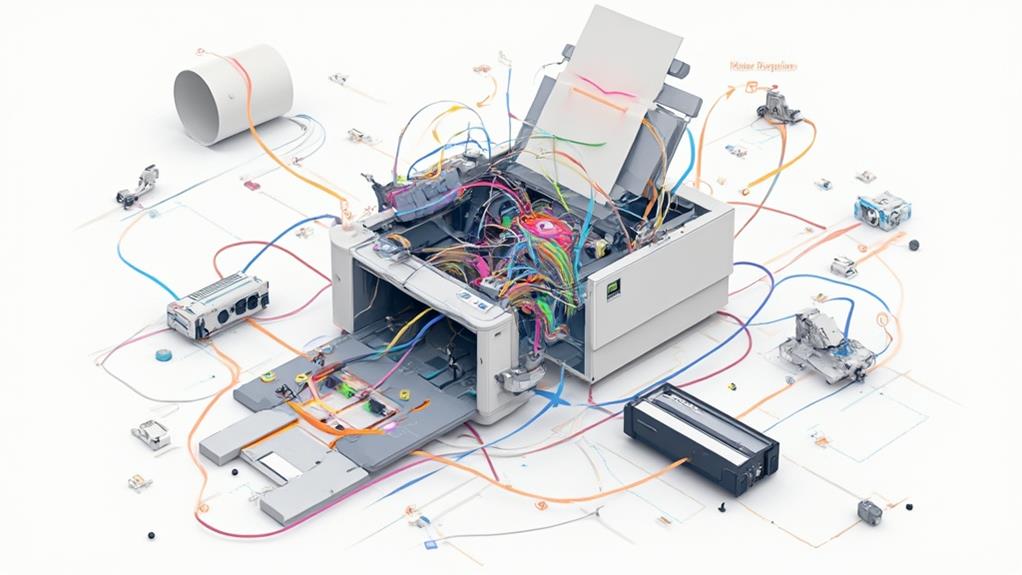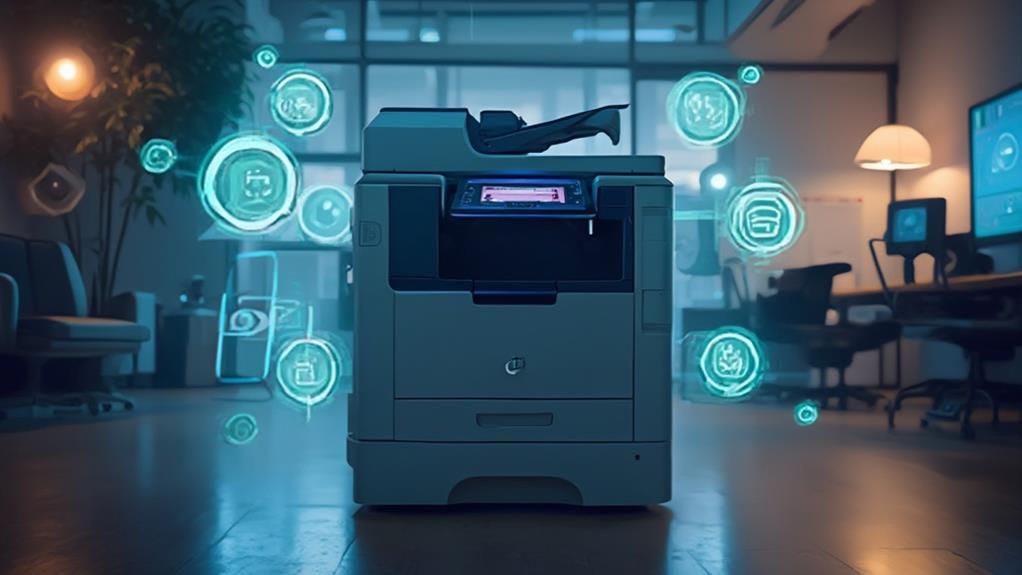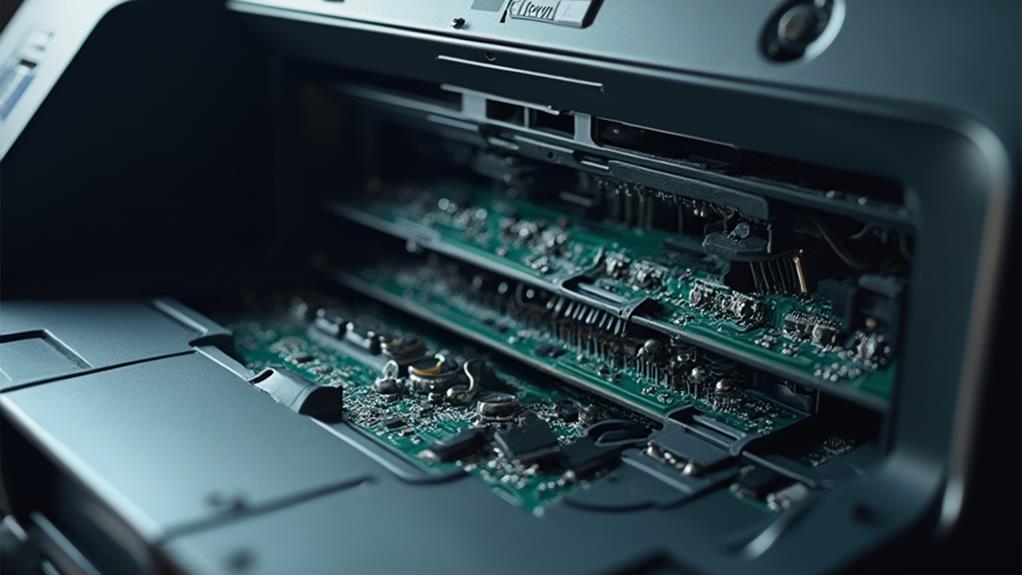The total cost of ownership (TCO) of a multi-function (MF) printer is influenced by several key factors. The initial purchase price forms the baseline, with higher costs linked to advanced capabilities and reputable brands. Maintenance and repair are crucial for maintaining performance, with costs depending on frequency, severity, and availability of parts. Consumable supplies, including toner or ink cartridges, paper, and replacement parts, considerably affect ongoing costs. Efficient design can mitigate systemic failures, while bulk purchases and cautious usage help manage expenses. Exploring these elements in detail can enhance budgetary foresight and informed decision-making regarding your MF printer's ownership.
MF Printer Lease Highlights
- Initial purchase price is influenced by printer capacity, functionality, and brand reputation.
- Maintenance and repair costs significantly impact total ownership expenses over the printer's lifespan.
- Consumable supplies such as toner, ink cartridges, and paper are continuous operational costs.
- Regular maintenance and efficient design can reduce potential repair costs and failures.
- Bulk buying and strategic usage of consumables can lead to better cost efficiency.
Total Cost Ownership Breakdown

When evaluating the total cost of ownership of a multifunction printer, it is essential to ponder three key components: the initial purchase price, ongoing maintenance and repair expenses, and the cost of consumable supplies. Opting for a copy machine lease can alleviate the burden of high upfront costs, allowing for predictable, manageable monthly payments.
The initial purchase price provides a baseline for understanding the financial outlay required to acquire the device. Over time, maintenance and repair costs, as well as recurring expenses for consumables like toner and paper, drastically contribute to the overall expenditure, impacting the long-term value of the investment.
Initial Purchase Price
The initial purchase price of a multifunction printer (MF printer) serves as the foundation for the total cost of ownership analysis. This price represents the upfront investment that organizations and individuals make to acquire the machine. It is crucial for potential buyers to understand that the initial price is just one component in calculating long-term expenses. Although the allure of a lower purchase price may capture attention, it is essential to consider the overall value derived from the printer.
When evaluating the initial cost, factors such as the printer's capacity, functionality, and brand reputation should be taken into account. High-capacity printers with advanced capabilities often have a higher purchase price. However, they might offer enhanced productivity, making them a cost-effective choice over time. Additionally, established brands may command higher initial prices due to perceived reliability and customer support, contributing to greater peace of mind.
Furthermore, assessing whether the printer includes basic consumables like ink or toner cartridges can influence initial budgeting. These inclusions can offset short-term expenses and provide operational continuity from the onset. Prospective buyers are encouraged to contemplate these dimensions alongside the initial purchase price to ensure an informed decision, fostering a sense of belonging within the community of savvy buyers.
Maintenance and Repairs
Beyond the initial purchase price, ongoing maintenance and repairs substantially contribute to the total cost of ownership for a multifunction printer. Regular maintenance is indispensable for ensuring peak performance and extending the device's lifespan, thus avoiding unexpected failures and costly repairs.
Most manufacturers and suppliers offer maintenance contracts, which can include routine inspections, cleaning, and part replacements, all designed to minimize downtime and ensure reliability. These agreements can be beneficial, providing peace of mind and predictable budgeting.
However, the costs associated with repairs can vary dramatically depending on the frequency and severity of issues encountered, the complexity of the technology involved, and the availability of parts. Selecting a printer model with a solid reputation for reliability can mitigate these unforeseen expenses, potentially leading to significant savings over time.
Furthermore, considering a multifunction printer with an efficient design can decrease the likelihood of systemic failures. It's essential to evaluate the warranty coverage and post-warranty support options offered by manufacturers, as well as the strength of their service network. Engaging with a community of users, sharing insights and experiences, can also provide invaluable support, fostering a sense of communal knowledge and shared trust.
Consumable Supplies Cost
Among the various components influencing the total cost of ownership for a multifunction printer, consumable supplies emerge as substantial factors. Consumable supplies typically encompass toner or ink cartridges, paper, and occasional replacement parts like the fuser or drum unit. These items, while individually minor, accumulate over time to constitute a considerable expense, making it essential to understand their impact on budget and operational planning.
Toner and ink cartridges, for instance, need regular replacement, influencing ongoing operational costs. The lifespan of these supplies can vary considerably depending on usage patterns and printing volumes. Lower yield cartridges may initially be less expensive but could lead to higher long-term costs compared to high-yield alternatives.
Paper usage also contributes to cost considerations. Choosing different types of paper for various printing needs might affect both quality and expenses. Bulk purchasing and judicious usage can contribute to cost efficiency, achieving a balance between quality and expenses.
Replacement parts like fusers and drum units further add to consumable costs. While less frequently changed, they require periodic attention and can be costly when needing replacement. Understanding these factors can help organizations make informed decisions, optimizing the total cost of ownership for their multifunction printers.
Reliable Office Equipment Solutions for Your Business
At Reliable Office Equipment Solutions, we understand that managing office resources efficiently is critical to the success of your business. Our extensive services are designed to provide cutting-edge solutions that seamlessly integrate with your workflow, ensuring minimal downtime and maximum productivity.
By leveraging our expertise in Managed Print Services (MPS), such as through our optimal leasing options, we can help optimize your total cost of ownership (TCO) for your multifunction printers (MFPs) by analyzing current usage, predicting potential needs, and offering tailored maintenance plans.
We offer a full line of office equipment solutions, with financing available, to best suit your needs. Utilizing industry best practices, such as regular device monitoring and proactive supply management, our goal is to reduce overhead costs and extend the lifespan of your equipment.
With Reliable Office Equipment Solutions as your partner, you can focus on your core business operations while we handle the complexities of office equipment management.
Benefits

Investing in an MF printer offers several advantages, including enhanced workflow efficiency and reduced operational downtime, which greatly bolster productivity within an office environment. By switching to newer models with advanced features like printing, scanning, and sending files, businesses can leverage programs designed for companies of all sizes to maximize efficiency further.
Enhanced Workflow Efficiency
Harnessing the power of an MF printer can greatly enhance workflow efficiency, a critical benefit for any organization attempting to streamline operations. As a central hub for document management and processing, an MF printer can optimize various functions like copying, scanning, and printing while integrating seamlessly with existing systems. This integration eliminates unnecessary steps in workflows, thereby speeding up the document lifecycle and freeing up employee time for more strategic tasks.
Modern MF printers also offer advanced document handling features such as automated sorting and stapling, which reduce manual intervention. Such capabilities further improve efficiency by ensuring consistency and reducing human error during document processing. Additionally, the ability to digitize documents directly into secure networks means that accessing and sharing information becomes swift and seamless, fostering collaborative efforts among team members.
Customization options based on specific business needs empowering employees to perform tasks with minimal interruption, achieving maximum productivity levels. User-friendly interfaces on these devices reduce the learning curve for staff, allowing for immediate and consistent improvements in workflow processes. By fostering an environment where tasks are effortlessly managed, MF printers provide a sense of unity and shared purpose, aligning operational goals for organizational success.
Reduced Operational Downtime
Operational downtime can be a significant hindrance to productivity, impacting both the efficiency and financial health of an organization. For businesses relying on multi-function (MF) printers, reduced operational downtime is an essential benefit that directly contributes to minimizing the total cost of ownership. By ensuring the continuous operation of these devices, businesses can avoid interruptions in tasks such as printing, scanning, copying, and faxing, all of which are integral to maintaining a streamlined workflow.
The advanced technology embedded in modern MF printers, such as predictive maintenance capabilities and high-reliability components, plays an essential role in minimizing downtime. Predictive maintenance leverages data analytics to foresee potential issues before they become problematic, allowing for proactive interventions that keep printers running smoothly.
In addition, robust design and durable materials reduce the frequency and impact of mechanical failures, thus decreasing costly repair needs and increasing the lifespan of the equipment.
In a collaborative environment where time-sensitive projects are the norm, reduced operational downtime provides a sense of reliability and trust among team members. This not only enhances organizational integration but also reinforces a collective focus on achieving shared goals, thereby fostering a culture of productivity and efficiency.
Optimized Resource Utilization
Alongside minimizing downtime, optimizing resource utilization is a pivotal factor in reducing the total cost of ownership for multi-function (MF) printers. Efficiently managing resources not only encompasses energy and material consumption but also the effective deployment of human resources responsible for managing printer operations. By ensuring that these devices are utilized to their full potential, organizations can significantly cut costs associated with excessive energy use and unnecessary consumable expenditures.
A central aspect of optimized resource utilization is adopting intelligent software solutions that monitor and regulate printer activities. These systems smartly allocate printing tasks, minimizing redundant usage and distributing workloads evenly across available printers. This leads to enhanced operational efficiency and prolongs the device's lifespan by preventing wear and tear from overuse.
Investing in training and development for staff managing these printers also plays a fundamental role. Well-trained personnel who understand the full capabilities of their MF printers can make informed decisions about when and how to use them efficiently. In addition, adopting environmentally sustainable practices, such as default duplex printing and using recycled paper, further reduces operational costs.
Ultimately, by optimizing resource utilization, organizations foster an environment where each member feels integral to the cost-effective and sustainable functioning of the office technology ecosystem.
Streamlined Document Management
Efficiently managing documents with modern multi-function printers offers a multitude of benefits that contribute to reducing the total cost of ownership. One primary advantage is the consolidation of various document handling tasks into a single device, consequently streamlining processes. This consolidation minimizes the need for multiple pieces of equipment, reducing maintenance costs and energy consumption.
An organized approach to document handling increases productivity, as time spent searching for files or operating multiple machines is considerably decreased. Moreover, advanced document management features in these printers, such as digital storage and retrieval systems, enhance collaboration within teams. Employees can access documents easily from shared drives, fostering a sense of unity and shared purpose, as everyone can seamlessly contribute to ongoing projects.
Such efficiency not only boosts morale but also reduces the margin of error, ultimately saving time and resources. Additionally, by reducing the dependency on paper, organizations support sustainability goals, align with environmentally conscious practices, and appeal to like-minded stakeholders. Streamlined document management, therefore, extends beyond cost savings, enhancing operational efficiency and fostering a culture oriented towards collective achievements.
This integration of technology and teamwork solidifies the printer's role as an essential component of modern, cohesive workplaces.
Expertise in Copier Leasing

Expertise in copier leasing presents numerous advantages, including structured lease agreements that simplify financial planning, contribute to long-term cost savings, and guarantee comprehensive maintenance and support services are in place. Leasing arrangements often feature predictable monthly costs, reducing unexpected expenses and allowing businesses to allocate resources efficiently. Below is a comparison of key factors related to copier leasing:
| Factors | Lease Agreements | Purchase |
|---|---|---|
| Initial Costs | Low | High |
| Monthly Costs | Predictable | Variable |
| Maintenance Services | Included | Often Extra |
| Technological Updates | Easy Upgrades | Limited |
| Long-term Expenses | Generally Lower | Potentially Higher |
Benefits of Lease Agreements
Leasing agreements offer a strategic advantage for businesses aiming to optimize the total cost of ownership for their multifunction printers (MFPs). By entering into a lease agreement, organizations can access the latest technology without the substantial upfront costs associated with purchasing. This financial model supports cash flow management by spreading expenses over time, which can align with budget cycles and operational strategies. Businesses can allocate their resources more efficiently, contributing to a shared sense of prudence and community in financial planning.
Furthermore, lease agreements often include maintenance and support services, ensuring consistent performance and reducing downtime. This integrated approach helps businesses maintain high productivity levels, fostering a sense of reliability and belonging to a network committed to operational excellence. Customizable terms offer flexibility, allowing companies to upgrade to newer models as technology evolves, ensuring they remain competitive without the burden of obsolete equipment.
Lastly, the simplicity of a lease agreement consolidates multiple expenses into predictable monthly payments. This transparency aids in precise budgeting and forecasting, providing businesses clarity and control over their operational expenses. By leveraging leasing agreements, companies can strategically manage their printing needs, aligning technological infrastructure with their overarching organizational goals.
Long-term Cost Savings
Achieving long-term cost savings in copier leasing requires a strategic approach that capitalizes on the expertise of industry professionals. By leveraging this expertise, organizations can navigate the complexities of leasing agreements, guaranteeing that they select packages best suited to their operational needs and financial constraints.
Professionals in the field provide invaluable insights into innovative financial structures, allowing companies to reduce upfront costs while optimizing cash flow over time. Moreover, industry experts help decode the intricacies of total cost of ownership, enabling businesses to focus on reducing hidden expenses associated with copier usage. They assist in determining appropriate usage scenarios and volume requirements, which directly influence cost-effectiveness.
An informed choice can prevent overinvestment in unnecessary features or capabilities, hence promoting financial efficiency throughout the leasing period. Engaging with leasing specialists fosters a sense of community, bringing individuals into an informed network where shared experiences and collaborative strategies drive mutual success. This alignment with knowledgeable partners guarantees that each organization's leasing decisions support sustainable fiscal health.
The benefits extend beyond cost savings; they provide a framework of trust and accountability that, in turn, contributes to the broader community's stability and growth within the copier leasing landscape.
Maintenance and Support Services
Integral to successful copier leasing strategies is the role of maintenance and support services, an often-overlooked component that dramatically impacts total cost of ownership. These services guarantee that your multi-function printer operates efficiently and reliably over time, minimizing unexpected expenses. A well-structured maintenance agreement nurtures peace of mind, fostering a sense of belonging within the organization by reassuring members that their technological infrastructure is robust and dependable.
Maintenance services typically include routine check-ups, timely updates, and immediate attention to technical issues. They extend the life of your printer, reduce downtime, and, importantly, help maintain consistency in your operations. Support services, on the other hand, offer professional assistance, ensuring that any disruptions are swiftly handled, thus solidifying the internal culture of reliability and cooperation.
For businesses seeking community and connection, strong maintenance and support systems create a bond by facilitating seamless communication and reducing technical barriers. When selecting a copier leasing option, consider providers offering all-encompassing support packages. These not only preserve your equipment but also fortify the collective efficiency of your team, ultimately anchoring the organization's capabilities and securing its competitive edge in an ever-evolving market.
Connect With A Team Member Today!
Looking to optimize the total cost of ownership for your multifunction printer? JR Copier USA, with over 25 years of experience, specializes in helping businesses with their office equipment needs.
Our expert team is ready to help you navigate your options and find the perfect solution. Don't leave your printing efficiency up to chance—connect with a team member today and start saving! Call us at (888) 331-7417.
Office Equipment Lesing FAQ
What Impact Does Energy Consumption Have on the Total Cost of Ownership?
The impact of energy consumption on total ownership cost is significant, affecting both operational expenses and sustainability goals. Efficient energy use promotes cost savings and aligns with collective efforts to embrace environmentally responsible practices within your professional community.
How Does User Training Affect the Maintenance Costs of an MF Printer?
User training markedly reduces maintenance costs by enhancing operational efficiency, minimizing errors, and extending the printer's lifespan. Proficient users guarantee optimal usage, thereby decreasing the likelihood of malfunctions and the need for frequent technical support.
Are There Any Tax Implications Related to Owning an MF Printer?
Owning a multifunction printer may have tax implications, including possible deductions for business expenses. Businesses should consult with tax professionals to guarantee compliance and optimize potential benefits, fostering a sense of community through shared knowledge and support.
How Often Should an MF Printer Be Serviced to Minimize Costs?
Regular maintenance is essential for minimizing costs associated with an MF printer. Biannual servicing guarantees optimal functionality, reducing long-term expenses and prolonging device life. A proactive maintenance schedule fosters a sense of shared responsibility and enhances operational efficiency.
What Is the Resale Value of an MF Printer After Certain Years of Use?
The resale value of a multifunction printer varies based on brand, model, and maintenance history. Typically, depreciation occurs over three to five years, with well-maintained units retaining higher value, fostering a sense of satisfaction and community trust.
